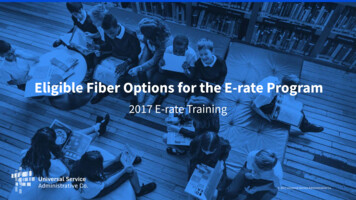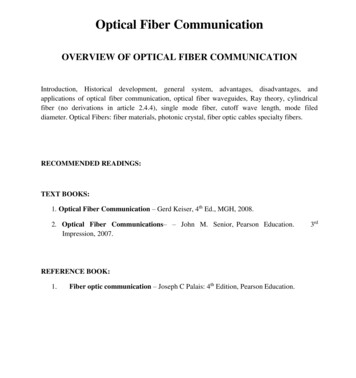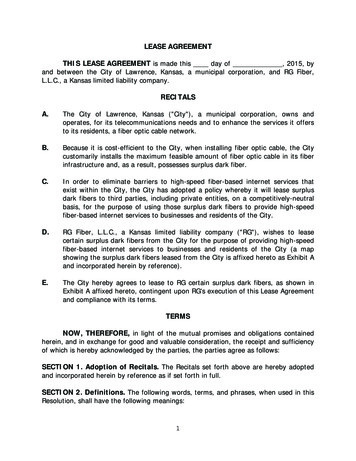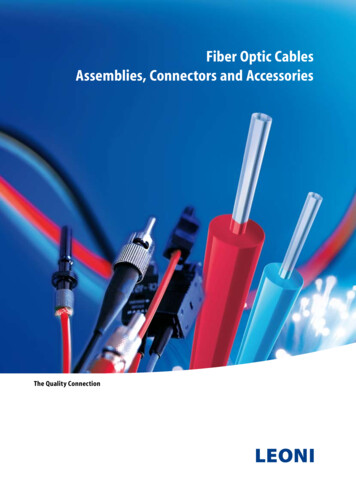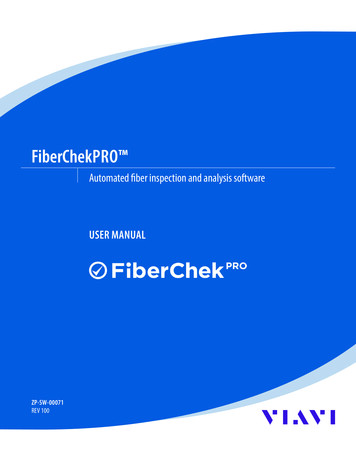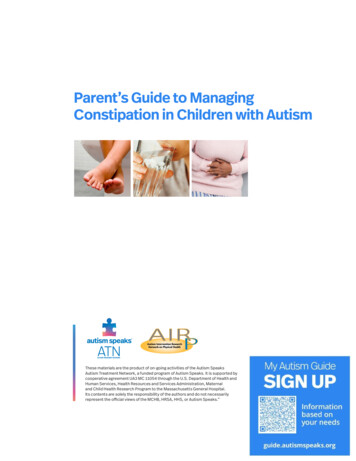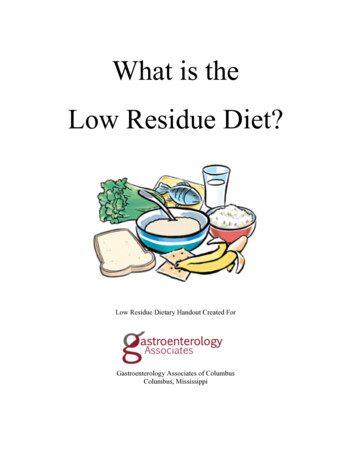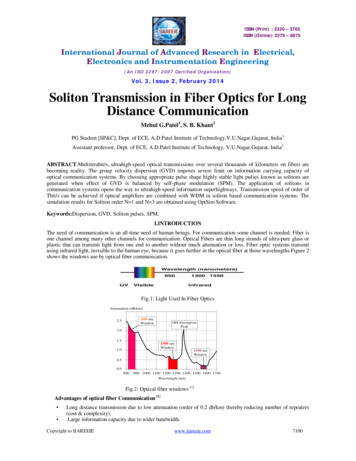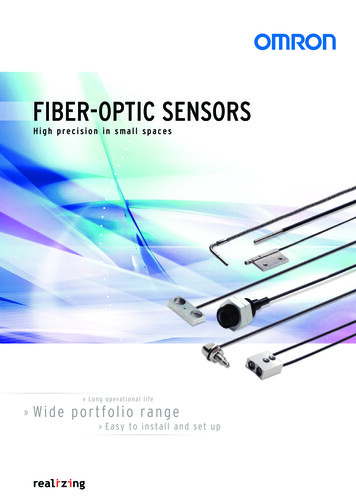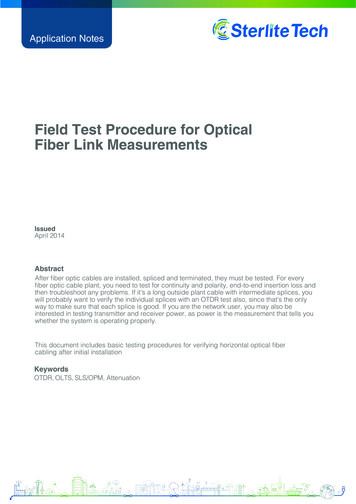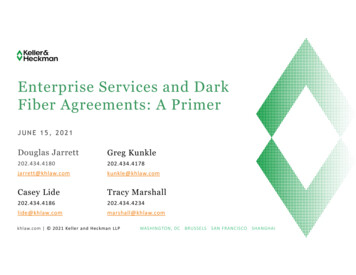
Transcription
Enterprise Services and DarkFiber Agreements: A PrimerJUNE 15, 2021Douglas JarrettGreg kle@khlaw.comCasey LideTracy hall@khlaw.comkhlaw.com 2021 Keller and Heckman LLPWASHINGTON, DCBRUSSELSSAN FRANCISCOSHANGHAI
DisclaimerThis program, and the presentations and material, provideinformation about the law. Legal information is not the sameas legal advice, which involves the application of law to anindividual's specific circumstances. The interpretation andapplication of the law to an individual’s specific circumstancedepend on many factors. This presentation is not intended toprovide legal advice. 2021 Keller and Heckman LLP 2
Dark Fiberkhlaw.com 2021 Keller and Heckman LLPWASHINGTON, DCBRUSSELSSAN FRANCISCOSHANGHAI
Background: What is “Dark Fiber”? An unactivated fiber optic strand, one of many within afiber optic cableThe right to activate or “light” a fiber optic strand can bedistinct from the ownership interest in the underlyingphysical facilityThe owner of the facility may grant an IRU or leaseholdinterest in dark fiber. Grantee/lessee may then activate anduse the fiber to transmit informationA dark fiber transaction involves a right to use a physicalfacility, not a service; not “telecommunications” 2021 Keller and Heckman LLP 4
Why Dark Fiber Grantee: Obtain essential element at relatively low cost, fixed price Control: Grantee provisions / configures / manages / upgrade electronics Ability to expand capacity Generally, a long-term commitment by Grantor Reduced network security risk Grantor: Monetize an unused, surplus asset Potential swap component Common element of P3 deals 2021 Keller and Heckman LLP 5
Common Providers of Dark FiberRegional network operators (but not large incumbents) Electric cooperatives Metro-area networks (possibly as anchor tenants) Municipally owned utilitiesMunicipal broadband initiatives: (Westminster, MD, Huntsville, AL, etc.)Some cable operators Zayo, Uniti, Lumen, Crown Castle, etc. Investor-owned electric utilities (less so for last-mile) Typically not available from: Major wireline carriers (AT&T, VZ, CenturyLink) Major wireless carriersMajor cable operators 2021 Keller and Heckman LLP 6
Principal Dark Fiber Customers Wireless carriersWireline service providers (2nd and 3rd tier)Major technology companies, enterprisesState R&E/nonprofit networks (middle mile)Geographically concentrated health care facilitiesSchools and librariesMunicipal P3 arrangement 2021 Keller and Heckman LLP 7
Dark Fiber Transactions IRU: “Indefeasible Right of Use” Long term, for usable life of the asset (typically 20 years) mostly upfront (hence “indefeasible”) Ownership may transfer at end of term Normally able to be treated as a capital cost, not operating expense Almost a sale Bankruptcy implications (favorable for grantee)Lease More flexibility on term length Payment can be spread over time Treated as opexLicense Less common in dark fiber context Less protective of grantee rightsTerminology is not dispositive. 2021 Keller and Heckman LLP 8
Key terms: IRU vs. LeaseContract ProvisionIRUTerm and Renewal 20 year term; renewals vary; titlemay transferUse of fibers; physical access Grantee sole right to use; networkoperator/owner often sole right ofphysical accessPayments Grantee typically pays 50% upfrontPhysical maintenance Typically by network operator; maybe annual maintenance feeNetwork operator’s bankruptcy Grantee retains IRU as equitableproperty interestRelocation Cost may be shared with others incable pro rataLease1-5-year term; multiple renewalsavailable; subject to termination byeither party at end of termLessee sole right to use; networkoperator/owner sole right of physicalaccessLessee may pay NRC forconstruction; plus periodic rentBy network operator, typically part oflease fee/rentPart of bankrupt’s estate; may berevokedCost typically absorbed by Lessor 2021 Keller and Heckman LLP 9
Other Terms Underlying rights Easements, ROW access, property access, attachment rights, permitsConstruction terms Route delineation, acceptance, testing (OTDR), premises entries,demarcation points Handholds, slack cableWarranty ITU compliant fibers; cable/fiber manufacturer’s specs., disclaimer ofimplied warrantiesIncident response terms Risk of loss Indemnification Use conditions/acceptable use policies 2021 Keller and Heckman LLP 10
Typical Fiber Agreement Structure Master Agreement Attachments: Route order (route description, pricing, delivery date) Acceptance criteria Warranty Maintenance obligations Collocation addendum Etc. 2021 Keller and Heckman LLP 11
Dark Fiber Pricing Most commonly: per strand, per mile, for a set termWide variation among markets, and among carriers in thesame marketRoute-specific, location-specific, and sometimes arbitraryColocation, splicing, make-ready may be added on topMetro-area vs. Long-haulExisting network vs. new construction vs. network extensionFiber count in cablePhysical route challengesRates generally not publicly available 2021 Keller and Heckman LLP 12
Telecommunications ServicesAgreementskhlaw.com 2021 Keller and Heckman LLPWASHINGTON, DCBRUSSELSSAN FRANCISCOSHANGHAI
Contents IntroductionProcurement ProcessThe Business DealAgreement StructureTerms and Conditions 2021 Keller and Heckman LLP 14
IntroductionReliabilityOptimum TechnologyOptimum PriceNetwork Security 2021 Keller and Heckman LLP 15
Introduction (2) Telecom services agreements are episodic; three-year deals oftenextended up to 10 years Telecom services agreements are “Master Purchase Agreements” Encompass domestic, International, or “rest-of-world” servicesCover new/different services during the term of agreementProcurements initiated for several reasons Enterprise-wide agreements preferred vs. “each business unit for itself deals”Better pricingExpanded requirements due to acquisitions or major growth spurtMigration to new technologyDissatisfaction with current service provider(s)Primary and secondary carriers are common 2021 Keller and Heckman LLP 16
Introduction (3)Transmission ServicesManaged Services Wireline Voice Services (VoIP/SIP) SD-WAN Data Services IVRS (Call Center Technology) Special Access (Ethernet & TDM) Router Management Private Line (Ethernet & TDM) Security Services MPLS Dedicated Internet Access Impact of USF surcharges, statetransaction taxes and state surcharges Firewall DDOS Intrusion Detection Proxy Server Service 2021 Keller and Heckman LLP 17
Procurement Process Threshold Question: Exclusive reliance on in-house procurementand IT departments or engage consultants to support theprocurement Telecom Consultants’ value: Current knowledge of market pricing Carriers’ business drivers More experience in Telecom Service Procurements Comprehensive RFP Current locations, circuit/port capacities and voice usage CurrentInventory Projected capacity/usage requirements Preferred technologies Preferred business and legal terms and conditions 2021 Keller and Heckman LLP 18
Procurement Process (2) Timely RFP – Why is this important? Two reasonsRFP should include business and legal terms and conditions;counsel should review legal Ts and CsRoles of consultant and enterprise staff and counsel vary innegotiations with carriersConsider cost/duration of transition process Orders must be placed, processed, new services installed, andtested Incumbent provider’s services must be disconnected Connectivity to locations cannot be disrupted during serviceprovider transitions 2021 Keller and Heckman LLP 19
The Business Deal Pricing Principles and MechanismsFixed rates vs. % Discounts of Service Guide rates Non-recurring vs. recurring charges Minimum Commitments Central to service provider’s business case Min. commitment and projected spend Exclusivity commitments are the exceptionAnnual, Term, or Service-Specific Achievement Credits Periodic Pricing ReviewsBusiness Downturn Provision 2021 Keller and Heckman LLP 20
The Business Deal (2) Service Level AgreementsService Level Metrics Service-specific Latency Found in Service Guides;Substance rarely negotiableService issues must be reportedCredits offered as exclusiveremedy JitterPacket LossProvisioningAvailability/MTTR What may be negotiable? Escalated remedies for recurringproblems generally or at corelocations Challenges of contract/servicetermination Unplanned transition isproblematic for customerCarrier cap on damages 2021 Keller and Heckman LLP 21
Master Agreement Service provider’s standard documents (including onlinedocuments) Service provider’s standard terms and conditions May not include customer-friendly provisions “accepted” in RFPs Links to online documents – AUP, Privacy Policy, and StandardRates, SLAs, Standard Agreements Service provider’s precedence provision Negotiated pricing and rates in attached pricing schedules SLAs attached as schedules or posted online 2021 Keller and Heckman LLP 22
Agreement Components Standard terms, policies and rules for all services/agreementsgenerally posted in service provider’s online Service Guide Standard terms and conditions Service pricing schedules (“Rack rates”) Service Level Agreements (SLAs) Acceptable Use Policy (AUP) Privacy Policy Network Security Policy **Beware of carrier’s reservation ofright to change online documentsand customer’s standard limitedremedy. 2021 Keller and Heckman LLP 23
What’s Negotiable? The Business Deal Fixed rates, not percentage discounts Term and Transition ClauseMinimum Commitment; Mitigation clause for failing to meet minimum commitmentCompetitive pricing reviews Pricing for current and projected primary servicesWhen, with who’s assistance, consequences for failing to agreeConfidentialityMinimum service period necessary to waive non-recurring chargesInformal billing dispute resolution clauseModifications to standard SLA remediesTechnology upgrade provision (a drafting challenge)Carriers typically do not object to service substitution (MPLS to Internet access) Carriers concerned with loss of revenue and migrating service to another provider 2021 Keller and Heckman LLP 24
Service Provider’s Acceptable Use out/terms-conditions/acceptable-use-policy 2021 Keller and Heckman LLP 25
Service Provider’s Privacy ivacy/ATT MOW-Business-CustomerPrivacy-Notice.pdf 2021 Keller and Heckman LLP 26
Collection and Use of Customer Information Different types of information Confidential information Customer data Customer Proprietary Network Information (CPNI) Data securityLimitations on access and useLimitations on sharing 2021 Keller and Heckman LLP 27
What’s Negotiable – Terms and Conditions Customer’s standard technology agreements are useful guide/starting pointfor responding to service provider’s standard terms and conditionsCarriers unlikely to modify standard damages cap/remedies, indemnities, orwarrantiesLimit consequences of non-compliance with AUPIP warranty unlikely; carrier’s IP indemnity warrants close lookConfidentiality clause should preserve confidentiality of aggregate info oncompany locations and customer-data in RFP and network designUnderstand precedence of “contract” over Service Guide and Online Policies Modify accordinglyFocus on partial termination rights to address recurring service problemsChoice of law, ADR or not, and venue—a priority for international and foreignservicesSignatory vs. entities providing services 2021 Keller and Heckman LLP 28
Greg KunkleThank You202.434.4178kunkle@khlaw.comAny questions?Casey Lide202.434.4186lide@khlaw.comDouglas JarrettTracy ASHINGTON, DCmarshall@khlaw.comBRUSSELSSAN FRANCISCOSHANGHAIkhlaw.com 2021 Keller 2021and KellerHeckmanandLLPHeckman LLP
Enterprise Services and Dark Fiber Agreements: A Primer Douglas Jarrett jarrett@khlaw.com 202.434.4180 JUNE 15, 2021 Casey Lide lide@khlaw.com 202.434.4186 Greg Kunkle kunkle@khlaw.com 202.434.4178 Tracy Marshall marshall@khlaw.com 202.434.4234
